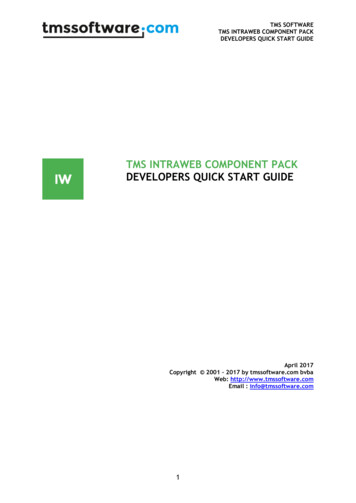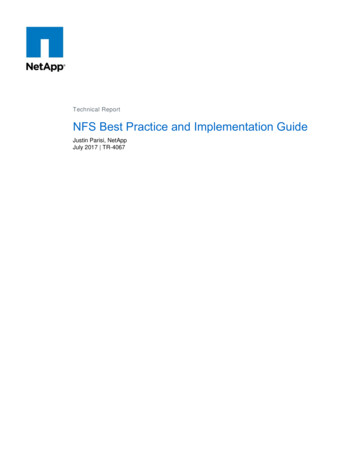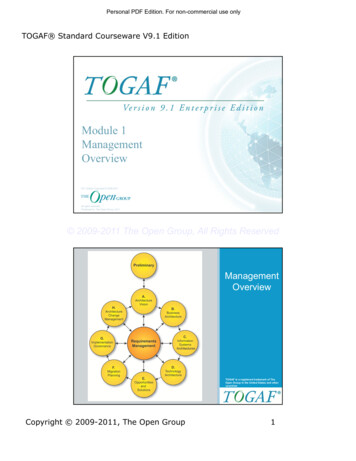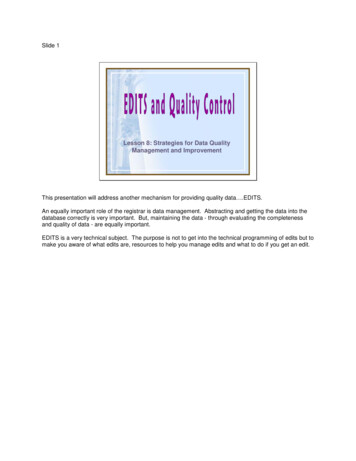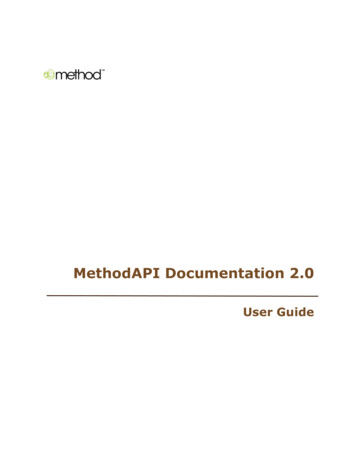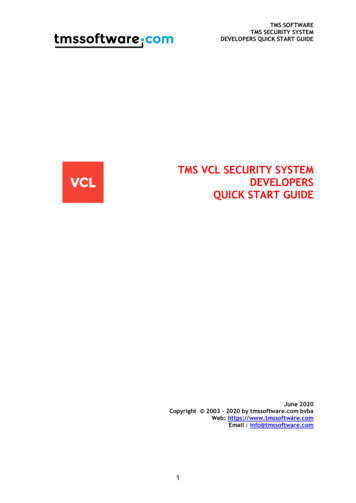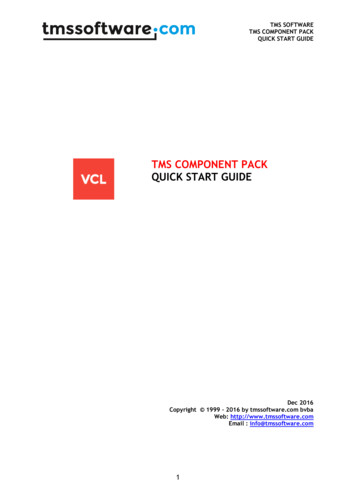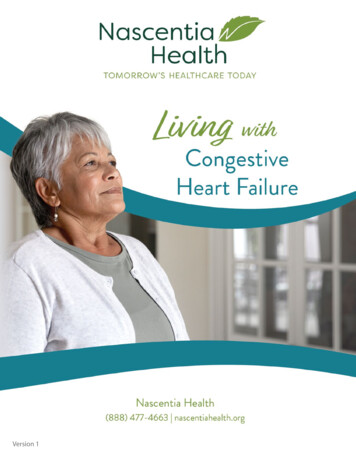
Transcription
Version 1
Things I’d like to discuss with my clinician:
CHF S.M.A.R.T GoalsSpecific Measurable Attainable Relevant TimelyPageTask2Explain your condition3Know about swelling in your feet and legs andhow to relieve it3Know why you should plan rest periods withyour legs raised above the level of your heart4How and when to obtain weight and when tocall MD6Symptoms of impending heart failure6Take safe steps to keep from getting infectionsor other diseases7Understand your medicines: what they look like,how much to take and when to take them8List any side effects and the effects certainfoods may have on how your medications work13Identifying sodium (salt) in your diet14Limiting fluids15Comfort measures for better breathing15Managing your stress16Exercise and heart failure17Limit activity only as endurance allows and planactivities around the time of the day, when youhave the maximum energy17Coughing and deep breathing18How to save energy19Smoking compliance-patient and family21Use of oxygen/safetyGoal MetDateNotesKnow about resources and support systemsthat are available to youLiving with CHF Nascentia Health1
1. What is Heart Failure?A word about heartfailureA healthy heart canpump blood to allparts of the body in afew seconds. When theheart can no longer dothis, blood that should bepumped out of the heartbacks up in the lungs andother parts of the body.When this happens, aperson has symptoms ofheart failure—shortnessof breath or swelling inthe hands, legs, and feet.Right AtriumLeft AtriumRight VentricleLeft VentricleMany people with heart failure have fluidbuildup in your lungs (congestion). So, heartfailure is often call CHF (congestive heartfailure).the blood. With treatment, an enlarged heartcan improve its pumping action. For most,treatment is daily medicines, rest, reducingstress, eating less salt and, often, limitingfluids.Heart failure can range from mild to severe.Most often the symptoms can be controlledwith medicines, rest, and diet. When heartfailure symptoms are found early andtreatment is started, a person with heartfailure can lead a more normal life. Manypeople with heart failure have an enlargedheart (cardiomegaly). This comes from yearsof the heart having to struggle to pump outWhen the heart is pumping as it should,blood returns from the veins to the rightupper chamber (atrium). From there it goesto the right lower chamber (ventricle) and ispumped to the lungs. The blood then returnsfrom the lungs to the left upper chamber(atrium) and then to the lower left chamber(ventricle) and is pumped out through themain artery (aorta) to the body.2Living with CHF Nascentia Health
2. Right Heart WeaknessWhen the right lower chamber starts tohave a pumping problem, blood backs upfirst in the veins. You may not notice it fora while since veins can expand to hold extrablood. Some days or weeks later you maynotice swelling in your legs and ankles. Youmay also notice soreness or swelling over theliver or in the upper right of your abdomen(belly). Other symptoms can be fatigue andloss of appetite.1. Sit with your legs raised, so your feet areabove the level of your heart2. Don’t stand for long periods3. Ask your doctor or nurse if supportstockings might be right for youDon’t cross your legs when sitting. This putspressure on the areas behind your knees anddecreases blood flow in your legs.Tips to Remember:How to check for swelling1. Elevate your lower legsPress your thumb into the top of your footand quickly remove it. Count how manyseconds go by before your skin smoothsback up. If the imprint of your thumb staysfor more than 3 seconds, this means you areholding fluid. Check your weight and callyour doctor or nurse.2. Be mindful of your salt intake3. Watch your fluid intake4. Use support stockings per your doctor’sorders.Be careful not to rub or bump swollen feet orlegs. This skin and tissue will damage easily.How to relieve swellingIf you have swelling in your feet and legs:12 inchesLiving with CHF Nascentia Health3
3. Left Heart FailureWhen the left lower chamber is notpumping as it should, some fluid will backup into the lungs. You may notice: shortnessof breath, a dry, hacking cough, spells ofwaking up breathless at night or not beingable to sleep unless propped up on pillows.Why your body holds fluidYou may also notice that your body holdsfluid. There is extra strain for the heartbecause now it must also pump the extra fluidalong with the usual amount of blood.A sudden weight gain is one sign that thekidneys are holding salt and water in thebody. To check for this, weigh each day (onthe same scale) at the same time (most oftenfirst thing in the morning). Record yourweight. You may be given diuretics (waterpills) to help you get rid of the extra salt andwater.Shortness of breath4When the heart sends less blood to thekidneys, they react as if the body doesn’t haveenough blood. Water and salt are then kept inthe blood rather than being passed out in theurine.Dry coughLiving with CHF Nascentia Health
4. Weight ChartDateWeightDiureticTakenMonitoring your weight Get on the scale first thing in the morning.(Urinate before you weigh). If you have a weight gain of 3 to 4 poundsin 1 to 2 days of normal eating, it is morelikely due to fluid rather than fat. Callyour doctor or nurse and do as he or shetells you to get rid of this extra fluid beforeit weakens your heart more. Often, morediuretic or another drug is needed. When checking your weight, think abouthow well you are eating. If you are eatingless and are losing pounds of fat, youmight not notice a gain from fluid.Tips to remember:1. Weigh yourself every day and keep aweight log.2. Use the same scale to weight yourself.3. Report weight changes of 3 pounds ormore in 24 hours or 5 pounds or more inone week to your MD.Living with CHF Nascentia Health5
5. How You May FeelAs heart failure develops, you may noticesome or all of these: Sudden weight gain (3 or 4 pounds ormore in 1-2 days or 2 pounds overnight) Swelling of the lower limbs (legs, ankles) Swelling or pain in the belly Trouble sleeping unless propped up on2 pillows (could be from problems otherthan heart failure)InfectionsAvoiding infections and staying health cankeep your heart failure symptoms fromgetting worse. When you have a feverand your temperature goes up, your bodymetabolism increases. This causes your heartrate to go up. Eat right and get plenty of restto avoid getting sick. Ask your doctor ornurse if you need to increase your fluid intakeif you have a fever. Shortness of breath (may be all of thetime, with exertion or only when wakingup) Breathless at night Requent, dry, hacking cough (most oftenwhen lying down) Loss of appetiteGetting very tired from hardly any effort canalso be a symptom of heart failure.6Living with CHF Nascentia Health
6. MedicinesFor your medicines to work best, you musttake them just as prescribed. Talk withyour doctor, nurse, or pharmacist to learnthese things about your medications: The name(s) of your medication(s) How and when to take (with food?) Side effects to watch for and what to do ifthey occur What to do if you miss a dose How one medication interacts with anyothers you are taking How certain foods affect yourmedications. Some foods may have a badeffect on your medications. Talk with yourdoctor or nurse about your medicationsand which foods or drinks you shouldavoid. Write them here:Fill in your medication chart, and post where it is easy for you to see.MedicationFood/drinks to avoidNOTE: Herbal supplements can interact with CHF medications.Ask your doctor or nurse before taking any herbal medications.Living with CHF Nascentia Health7
6. Medicines (Continued)If you feel worse than usual and find yourbreathing is worse than normal, tell yourdoctor or nurse. Your medications may needto be changed.While you are taking some heart medicines,you need to check your pulse rate. Ask yourdoctor or nurse for information on how totake your pulse and how often.Tell your doctor or nurse if your pulse: Is less than 50 or skips around (notregular) Is greater than 120 or skips around (notregular)CoumadinCoumadin is an anticoagulant or “bloodthinner.” It makes your blood take longer tomake prothrombin, one of the things thatmakes blood clot.Your doctor will decide how much Coumadinyou need to take based on a blood test calleda “PT” (prothrombin time). He or she maychange your Coumadin dose after your bloodtest if your blood takes too long to makeprothrombin. Your doctor may want to checkyour PT regularly.A number of things may affect your bloodtest results:8Pill boxes can help you organize yourmedications each weekCaution—Do not quit taking yourmedications—even if you feel better. Other medications (ask your pharmacistbefore taking any new medications) Sickness (flu, diarrhea, etc.) Diet high in dark green vegetablesTake Coumadin at the same time everyevening. This is so you can change the dose,under doctor’s orders, if needed, on the daysyou have a blood test.While you are on Coumadin, do nottake aspirin or over-the-counter antiinflammatory medicines, unless your doctorhas ordered it.Living with CHF Nascentia Health
6. Medicines (Continued)Foods and CoumadinFoods with vitamin K help your blood makeprothrombin and work against Coumadin.Ask your doctor, nurse, or dietician to helpyou plan your diet so that you do not eat toomuch of foods high in vitamin K. Some foodshigh in vitamin K are: Collard greens Spinach Turnip greens Broccoli Liver Oatmeal Cabbage Oats Cauliflower Wheat Egg yolksBrussels sproutsCall your nurse or doctor if you have: Different color urine or black stool Unusual bruising (black and blue markson your skin)Ace Inhibitors and othervasodilatorsAngiotensin-converting enzyme (ACE)inhibitors help relax your veins and arteriesto lower your blood pressure. ACE inhibitorsprevent an enzyme in your body fromproducing angiotensin II, a substance thatnarrows your blood vessels. This narrowingcan cause high blood pressure and forceyour heart to work harder. Angiotensin IIalso releases hormones that raise your bloodpressure.Vasodilators improve symptoms and helpkeep your heart failure from getting worse.However, they improve heart failure overmonths or years—not quickly. They haveproven to be very useful in improving mildto moderate heart failure. No matter howwell you feel, don’t stop taking your medicinewithout your doctor’s advice. A headache after a big fall or hitting yourhead hard New pain or swelling in your joints Fever or flu-like sickness More blood than usual when you brushyour teeth or get a cutAlways wear your Identification (ID).If you have an accident or pass out, an IDbracelet or necklace tells others that you areon a blood thinner. Ask your nurse or doctorhow to get an ID bracelet or necklace.Living with CHF Nascentia Health9
6. Medicines (Continued)Beta-blockersBeta blockers, also known as beta-adrenergicblocking agents, are medications that reduceyour blood pressure. Beta blockers workby blocking the effects of the hormoneepinephrine, also known as adrenaline.Beta blockers cause your heart to beat moreslowly and with less force, which lowers bloodpressure. Beta blockers also help open upyour veins and arteries to improve blood flow.Your doctor will choose which beta blocker isbest for you based on your health conditions.Digitalis GlycosidesDigitalis helps an injured or weakened heartpump more efficiently. It strengthens theforce of the heart muscle’s contractions, helpsrestore a normal, steady heart rhythm, andimproves blood circulation.If you have dizziness, severe weakness, severeleg cramps or other symptoms, your doctormay need to change your medicine. Askabout a potassium supplement, or eat morefoods with potassium, like white potatoes andbananas.One diuretic saves potassium as it gets rid ofexcess fluids. If you are taking it along withyour regular diuretic, you may not need extrapotassium. Ask your doctor or nurse aboutthis.What are side effects of diureticsWhen individuals present with fluidimbalance (depletion) due to diuretics,adverse events such as: Dry mouthDiuretics (fluid pills)With heart failure, your body tends to holdonto fluid. A diuretic (“water pill”) can helpyour kidneys make more urine and get ridof this excess fluid. It can also decrease theamount of fluid in your lungs, so you canbreathe better.You may notice that you pass more urine atnight. When you are lying down, more bloodcan go to the kidneys. This lets the kidneysmake more urine. Take your diuretic in themorning, to keep from having to get up at10night. If you take a diuretic twice a day, takethe second dose in the late afternoon, insteadof the evening. Thirst Weakness Lethargy Drowsiness Muscle pains or cramps Confusion Seizures Hypotension Tachycardia Digestive disturbancesLiving with CHF Nascentia Health
6. Medicines (Continued)PotassiumYour doctor will likely monitor yourpotassium levels. Potassium levels may beaffected by the use of fluid pills. Potassiumis a substance your body must have. It helpscontrol heart rhythm. Since most diureticscause you to lose potassium as you passmore urine, extra potassium (a potassiumsupplement) is often needed. (Leg cramps arecommon when your potassium gets too low.)High potassium foodsIn most cases where diuretics are used, foodalone can’t give the amount of potassiumneeded. Do what your doctor or nurse tellsyou to keep your potassium levels normal.Tips to remember:1. Know the actions, side effects, the reasonyou are taking the medication, when youshould take them, and what to report toyour nurse or doctor2. Use a prefilled planner device to helpremember your medicationsDried FruitsRaisins, prunes, apricots, datesFresh FruitsBananas, strawberries, watermelon, cantaloupe, orangesFresh VegetablesAvocados, white potatoes, beets, greens, spinach, peas, tomatoes,mushroomsDried VegetablesBeans, peasFresh MeatsCanned JuicesSalt SubstitutesTurkey, fish, beefGrapefruit, prune, apricot (Note: some canned juices, like tomatoand V-8, contain salt. Read all labels for salt, sodium, or sodiumcompounds [or NaCL, as salt is often written])Note: some have a lot of potassium. In some people too muchpotassium can be dangerous.Living with CHF Nascentia Health11
7. Eat Less SodiumSodium is an important substance thathelps your body balance the level of fluidsinside and outside of the cells. To keep upthis balance, the body needs about 200mg ofsodium a day. Yet, most of us eat 3,000mg to6,000mg of sodium each day.Most people with heart failure are asked toeat less sodium. Sodium attracts water andmakes the body hold fluid. To pump theadded fluid, the heart must work harder.Your doctor may recommend you limit yoursodium. Talk to your doctor about what isbest for you.One most common source of sodium istable salt. Table salt is 40% sodium and 60%chloride.If your doctor wants you to lower yoursodium intake here are ways Season foods with fresh or dried herbs,vegetables, fruits, or no-salt seasonings Do not cook with salt or add salt to foodsafter they are on the table. Make your own breads, rolls, sauces, saladdressings, vegetable dishes, and dessertswhen you can. Eat fresh or frozen, unsalted vegetables.If you do eat canned foods, rinse thembefore cooking. This removes some of thesodium.12HINT1 tsp salt 2,400mg sodium Buy water-packed tuna and salmon. Breakup into a bowl of cold water and let standfor 3 minutes. Rinse, drain, and squeezeout water. Bake, broil, boil, steam, roast, or poachfoods without salt. Don’t buy convenience foods such asprepared or skilled dinners, deli foods,cold cuts, hot dogs, frozen entrees orcanned soups. They have lots of salt. Read all labels for salt. A low-sodium labelmeans 140mg or less per serving. Try tobuy products labeled low-sodium or nosalt added. Stay away from “fast” foods. They arealmost always high in salt.Note: Some over-the-counter medicines arealso high in sodium.Tips to remember:1. Know how to review food labels toidentify high sodium content foods andsodium alternatives2. Know the importance of appropriatesodium levels, including a definition offoods high in sodiumLiving with CHF Nascentia Health
8. Limit FluidsMany people with heart failure havetrouble with their body holding fluid.Being very thirsty is also common. Even ifyou are thirsty, this does not mean that yourbody needs more fluid. You need to be carefulnot to replace the fluid that diuretics (“waterpills”) have helped your body get rid of. Tryusing small amounts of sugar-free hard candyto help with a dry mouth.Many doctors suggest that people with heartfailure limit their total fluid to 8 cups per day.This includes foods taken with medicines. Water Juice Tea Soda Yogurt Pudding Ice cubes Ice cream Coffee Milk Soup Jell-o Juices in fruits(1 orange or ½grapefruit countsas 4 oz. of fluid)Ask your doctor or nurse what your totalfluid intake per day should be and how tobalance out how much you drink during theday.Living with CHF Nascentia Health13
9. Comfort MeasuresWhen you have trouble breathing, it isimportant to stay as comfortable as youcan. This will help you breathe better andget more oxygen. With more oxygen, all thecells of your body work better and you will“feel better all over”. To increase comfort andimprove breathing, do these: Keep items you use often close at hand toavoid straining to reach them. When sitting or lying down, make sure allparts of your body are supported so youcan fully relax. Sit upright or propped up on pillows. (thislets your lungs fully expand and take inmore air). Prop your arms up on pillows, to let yourlungs expand even more. Prop head of bed up with blocks or booksor sit in a recliner. (This keeps fluid at baseof lung so you can breathe easier.) Avoid having room temperatures toowarm, (It is easier to breathe if air iscooled.) Do the things that help you relax. (Take awarm bath, listen to soothing music, etc.10. Manage StressLearning how to deal with stress andanxiety and seeking care for depressioncan help you manage CHF and feel betterin general.Stress is defined as feeling tense on the insidedue to pressures from the outside. Having achronic illness, such as heart failure, can bevery stressful. Since stress makes your heartwork harder, try to find ways to manage or14reduce the amount of stress your feel. Youmay feel depressed or angry because you haveheart failure. These feelings are normal, butit is important to learn to cope with them. Itmay help to talk about how you feel with yourfamily and friends. When you accept that youhave heart failure, you will be able to manageyour stress level better.Living with CHF Nascentia Health
11. ExerciseOne way to manage yourstress is with exercise.Although rest is neededwhen you have heartfailure, low-levelexercise can improveyour heart symptomsand your stress level.Check with yourdoctor or nurseabout a safe exerciseprogram for you.Tips for exercising safelyExercise andHeart Failure Dizziness The best time to exercise is about 1 hourafter eating or taking your medications. Stay away from strenuous exercise andavoid lifting heavy things. Start slowly and work up gradually.Stop the activity if you have any: Chest pain or discomfort Shortness of breath that is abnormal foryou NauseaThe idea is to exercise to keep the body strongbut avoid overworking the heart.Unless your heart failure is severe, you willmost likely be told to do some exercising.Exercise can be very helpful if you have heartfailure. This may sound confusing, if you havebeen told you have to rest a lot of and not gettired.Some moderate exercise you can do are:Exercise and your pulse rateTo check your pulse during and/or afterexercise, do this:1. As soon as you stop, find your pulse atyour wrist with your first two fingers asshown here.2. Once you have located your pulse, countit for 15 seconds.3. Multiply this number by 4. This is your1-minute pulse rate. Riding a stationary bicycle Brisk walking SwimmingIf you are not used to exercising, you mightstart with 5–15 minutes of easy exercise.Resting as often as you need to, so you willnot get tired or out of breath. Any amount ofexercise is helpful.Note: If you have an irregular heartbeat, countit for a full minute and don’t multiply by 4.Living with CHF Nascentia Health15
12. Saving EnergyUsing energy wisely can help you stayhealthy. Using less energy with each dailytask keeps you from getting tired easily andlets you do more things throughout the day.Here are some tips to make tasks easier anduse less energy: Relax. Spread your activities throughoutthe day and do them at your own pace. Plan ahead. Do the things that take moreenergy when you are at “your best.” Rest in between activities. Work slowly, and don’t feel bad if you can’tfinish a task. Finish it when you don’t feeltired. Do not lift heavy objects. (lift no morethan 5-10lbs.). Use objects that assist you, such asa walker, shower chair, or bedsidecommode. Get plenty of sleep. Avoid caffeine and anynoise or light in your room. Avoid straining when having a bowelmovement. Avoid getting too hot or too cold.16Living with CHF Nascentia Health
13. CoughingControlled coughing helps loosen themucus in your lungs. Do controlledcoughing with small, short coughs. Avoidlarge blasts of air.Exercise 1: Front1. Sit up, and lean head forward slightly.2. Place one hand on your chest to check formovement of the rib cage muscles.2. Take a deep, slow breath through yournose, and hold it for 2 seconds.3. Cough once (to loosen mucus).1. Sit comfortably with good posture, (sittingup straight), or lie on your back with yourhead and knees supported by pillows.3. Place the other hand on your belly to feelmovement of the diaphragm.4. Pull your belly muscles in as you breatheout slowly through pursed lips.Deep BreathingTo do deep breathing, you use a muscle calledthe diaphragm. Check how the diaphragmworks in these 2 ways: Feel it move on the front of your abdomen Feel it move on the sides of your abdomen5. Breathe in through your nose, feelingyour belly relax and push out to the front.6. Rest after 3 or 4 breaths.Exercise 2: Side1. Sit or stand comfortably with goodposture.2. Place your hands on your sides over yourlower ribs.3. Feel your lower ribs move down as youexhale slowly through pursed lips.4. Inhale slowly through your nose, feelingyour lower ribs expand.5. Rest after 3 or 4 breaths.Living with CHF Nascentia Health17
14. SmokingIf you smoke, find some way to quit.Smoking makes blood vessels narrow andbreathing hard. With every puff, a smokerirritates and damages the lining of the lungs.If you stop smoking, you can slow down theserious damage you are doing to yourself.Keep your hands busy. Try “handling” these:No matter how long you have smoked,stopping now will help you breathe better.Some helpful hints to get you started are: Fidget deviceKeep your body and mind busy.Changing your routines and patterns can alsohelp. If you can, take a short walk Wash dishes Read a good book Join a card club Sponge ball Pen or pencil Heavy coins Rubber band Paper clipA stop-smoking program may increase yourchances of success. Some popular programsinclude: Do some handwork (such as knitting) American Lung Associates (FreedomFrom Smoking) Go to a play, movie or concert Smokeless Watch a good video Smokenders American Cancer Society’s program18Living with CHF Nascentia Health
14. SmokingCheck with your health care provider or localhospital about other quit-smoking programsnear you. When checking out programs, besure to ask about cost, success rates, methods,instructors’ training and handouts.Medicaid pays for quit-smoking treatmentdelivered by your health care provider.Medicaid covers quit counseling and all sevensmoking cessation medications approvedby the U.S. Food and Drug Administration(FDA): Five nicotine replacement therapies(NRT)—patch, gum, lozenge, inhaler, andnasal spray Two non-nicotine oral medications(pills)—bupropion SR (brand namesZyban or Wellbutrin) and varenicline(brand name Chantix)Medicaid covers the use of two medicationsat once, which is safe for most people. Usingtwo medications as prescribed by yourprovider is even more helpful in reducingcravings and other withdrawal symptoms.And, because it may take you more thanone try to quit, Medicaid covers repeatedtreatment by your provider.Talk to your health care provider about whichtreatment might be right for you.E-cigarettes are not an FDA-approvedsmoking cessation medication. The FDAclassifies e-cigarettes as a tobacco product,just like the cigarettes, cigars, smokelesstobacco, and other tobacco products.Medicaid even pays for over-the-counternicotine patches, gum and lozenges with afiscal order (like a prescription) from yourprovider.Living with CHF Nascentia Health19
15. OxygenTreat oxygen just like any othermedication you take. Don’t change theamount, unless your doctor or nurse tells youto. Your doctor will tell you what your literflow should be when you rest, exercise, andsleep.The company that provides your oxygenequipment should fully explain its use andcare. When your supply arrives, be sure tofind out how to reorder.Plan ahead, sothat you donot run outin the middleof the night orover a weekend orholiday.Oxygen company phone number:To use oxygen safely: Store oxygen away from heat, directsunlight, or a pilot light If using cylinders, secure them so thatthey cannot tip over No smoking in the room where oxygen isused or stored Do not increase liter flow without askingyour doctor or nurse. Do not use oxygen near an open flame(such as a gas stove or fireplace) You can use electric appliances. But becareful when using things that mightspark (like an electric razor) Do not use petroleum-based products(such as Vaseline, certain creams, etc.)()-Liter flow at rest:Liter flow at exercise:Liter flow asleep:Hours and/or time of day to use:20Living with CHF Nascentia Health
15. OxygenTraveling with oxygenLonger TripsDon’t think that being on oxygen meansyou have to stay home all the time. You canarrange to have oxygen when you travel,whether you go around the corner or aroundthe world!Ask your oxygen company to arrange for youroxygen with a company in the town you planto visit, or you may make the arrangementsyourself.For ANY trip, be sure you know. How to change tanks when one is empty How to measure the amount of oxygen leftin the tank How to refill your tank (if you have aliquid oxygen system) All of the safety measures for oxygen useShort TripsYour oxygen company can set you up foroutings of up to 8 or 10 hours. The amountof time depends on tank size and on whetheryou use liquid or gas oxygen. If you useliquid, it can go in a pack that you carry onyour shoulder. Travel oxygen in gas formcomes in a small tank (“E” cylinder) that rollson wheels or in a smaller tank that can becarried.Traveling by airFor an extra fee, you can arrange throughthe airline to have oxygen while flying. Theairline provides the oxygen because travelwith any type of tank filled with oxygen isunsafe. Just tell the airline your liter flow rate,and they will do the rest. If you have a liquidoxygen system, you may want to take yourtank with you to use once you arrive. To dothis, just drain the tank dry, and leave thevalve on the top cracked open a little bit.Tips for setting up oxygen for a trip Know your flow rate. If you use a liquid oxygen system, know itsbrand name. Make sure the company youwill be using while you travel has the rightsize adapter to fill your tank. Because oxygen is a drug, always take awritten prescription with you when youtravel.Living with CHF Nascentia Health21
15. OxygenTips to remember:1. Remember that oxygen isused for low oxygen levels inyour blood2. Use the oxygen at the flowrate you MD has prescribedand do not increase3. Know the differentequipment associatedwith oxygen—cylinder,liquid tank, concentrator,flowmeter, pressure gauge fortank, nasal cannula, mask,sterile humidity bottle, steriledistilled water, and tubing4. Clean your nares and cannula2 times a day and as needed5. Check your ears and cheeksto prevent pressure soresfrom developing6. Keep oxygen away from flames.7. Avoid the use of heating pads and electricrazors, aerosol sprays, body lotions, facecreams and rubbing alcohol228. Never smoke cigarettes while usingoxygen because the oxygen supportscombustion9. Place a “no smoking” sign on your door towarn othersLiving with CHF Nascentia Health
16. Word SearchN L X D C H F O B X S M O KV E C B D D A RA FIIN G EG H T H E A R T NJ W J K H K M R B B X T W W E EO T S L R V W M E DCIN E G D RF H O E S T R E S S F AIL U R E GL E D KU AIIII Q W T E X E R CIS E M YS H O R T O F B R E A T H A OR U Q B Q H C O U G H L C N L A OD T M E W EIG H TI O F V T C X SS V J Q N A S C E N TIAIP M V WO E X H E A L T H Z O FJJF Y K KJ O G N R B D Y W A O X Y G E N F NNASCENTIAFAILURERIGHT HEARTCHFFLUIDSSHORT OF BREATHCOUGHHEALTHSMOKINGEDEMALEFT TLiving with CHF Nascentia Health23
ReferencesAgency For Healthcare Research andQuality, “Health Literacy UniversalPrecautions Toolkit, 2nd Edition, Use HealthEducation Material Effectively: Tool #12,”2018 kit.html)American Association of Heart FailureNurses “Destination Health Heart:A Roadmapto Managing Heart Failure, Heart Failurewith A Preserved Ejection Fraction,” 2015(aahfn.org/page/hfawarenessweek2015) “Every Day, Every Dose,” 2018 (aahfn.org/page/hfawarenessweek2018) “Spices of Life! Healthy Livingwith HF,” 2016 (aahfn.org/page/hfawarenessweek2016)American Heart AssociationAmerican Heart Association/AmericanStroke Association “Heart Failure,” 2018 (heart.org/en/healthtopics/heart-failure) “HF Guidelines Toolkit” (heart.org/en/health-topics/heart-failure/hear
Many people with heart failure have fluid buildup in your lungs (congestion). So, heart failure is often call CHF (congestive heart failure). Heart failure can range from mild to severe. Most often the symptoms can be controlled with medicines, rest, and diet. When heart failure symptoms are found early and treatment is started, a person with heart



